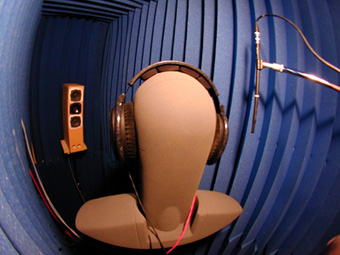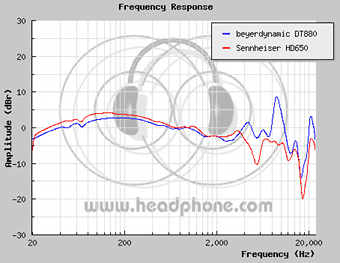![[SoundStage!]](../sslogo3.gif) Getting Technical Getting TechnicalBack-Issue Article |
September 2004 The Headphone Geeks of HeadRoom 
In the dimension in which audiophiles live, headphones receive little attention. Headphones, many believe, are mere accessories meant to provide convenient, portable sound. At HeadRoom, a company run by self-proclaimed "obsessed headphone geeks," they’re hoping to change that. The geeks behind this Montana-based company are driven to distraction by the inarguable fact that most headphones sound terrible. Their mission is to find the best headphones in the world, and, together with their own high-quality headphone amplifiers, provide headphone consumers with excellent sound. I interviewed HeadRoom’s owner and founder, Tyll Hertsens. In the process, not only did I learn a lot about headphones, but I also uncovered some surprising facts about our own human auditory system. Measuring for success HeadRoom began with Hertsens’ annoyance at the poor sound afforded by airplane headphones. In true geek fashion, his response was to develop a headphone amplifier, vastly improving the sound. Subsequently, he discovered that no comparable device was available in the audio market and, even more shocking, few audio companies even bothered to produce high-quality headphones. That was over ten years ago. Today, HeadRoom manufactures their own headphone amps and markets other manufacturers’ high-quality headphones. But they don’t simply sell these headphones -- they analyze their performance. Measuring headphones is difficult and costly, and since headphones are usually viewed as an accessory, many manufacturers don’t bother. Furthermore, not only are there a confusing array of international standards and methodologies for different types of headphone measurements, the results are difficult to compare and interpret.
Distortion HeadRoom examines the distortion products from 500Hz at multiples of the fundamental tone (second harmonic is 1000Hz, third harmonic is 1500Hz, etc.). In general, great-sounding headphones decrease in distortion as frequency increases; however, some really good headphones have quite a bit of distortion. According to Hertsens, you cannot look at the distortion numbers alone and determine if a headphone is going to sound good or not. They’ve found no clear correlation between distortion results and headphone performance -- yet. Impedance and isolation The second measurement is impedance, which indicates the headphone’s dynamic resistance in ohms over the frequency range. In general, a good result demonstrates low impedance; the lower the impedance, the easier it is to drive a headphone, and therefore the higher the volume can be. The third measurement is isolation, which measures how well the headphone blocks the outside noise. Depending on their design and type, headphones act differently. For example, open headphones will cut out some noise above 3kHz, while sealed headphones will cut out a good deal of noise down to 200Hz. The best isolation measurements are achieved by noise-canceling headphones and in-ear-canal headphones, which are the best by far. The uniqueness of headphone frequency response Hertsens finds frequency response the most interesting measurement because you can actually look at the numbers and get a feel for how the headphone will sound. A frequency-response graph plots frequency against loudness. At HeadRoom the headphones are tested with a series of 200 tones at the same voltage with ever-increasing frequency. The Head Acoustics microphone records the headphone’s output and sends it to the computer. With loudspeakers, the goal is a flat frequency response. This means that the speaker reproduces all frequencies at equal volume throughout the audible range of 20 to 20,000Hz -- what goes in comes out the same. But a flat frequency response with headphones is not the ideal. Headphones are a different acoustic configuration than loudspeakers, and because music is recorded from a speaker-based audio environment, music that may sound great with loudspeakers just doesn’t sound right with headphones. "Furthermore," Hertsens adds, "you are using only one driver to reproduce all frequencies. It’s physically impossible to have that small headphone driver sound flat at 20Hz." Just because the goal of the frequency-response graph is not flat does not mean there is not an ideal response. Hertsens describes the results of quality headphones.
"At higher frequencies headphones need to roll off because the drivers are close to the ear. High frequencies are absorbed more in rooms than low frequencies, and the ear compensates because it knows how a room sounds, so you want the headphone to roll off the high frequencies a bit. If there is a flat response, then the headphones will sound too bright. The graph should have a gently sloping flat line from 1kHz to about 5dB down at 20kHz." Another characteristic typical of headphone frequency-response curves is a lot of peaks and valleys in the high frequencies. Hertsens explains that this is normal and in part due to reflection cancellations in the folds and ridges in the outer part of the ear. Ideally, however, the peaks and valleys of the frequency response should average out to a flat line and should be less than 3kHz in width or the sound will be noticeably colored. Subjectivity of headphones Sounds like science to the rescue, right? Unfortunately, no matter how sophisticated the measurement technique, it’s unlikely that the audio industry will ever arrive at complete agreement on which products produce "the best sound." Audio products cannot be judged objectively because hearing is, by its very nature, a subjective experience. This subjectivity is even more pronounced when comparing loudspeakers against headphones, where the individual natures of our auditory systems play an even greater role. "Of course, there are some norms that you can use to compare headphone performance," Hertsens states. "But headphones are unique in their measurement. Loudspeaker measurements are done at a distance -- in the far field -- but with headphones the measurement occurs in the near field." The near field is the distance of one-half of a wavelength between the listener and speaker. With a distance this short, it’s impossible to separate the headphone from the ear -- everything from the driver resonances to the impedance of the ear canal affects the measurement. The sounds reach the listener directly, which removes the point of reference that occurs when measuring in the far field. "There is no flat anywhere," says Hertsens. "We assume the far field is flat and that the near field is not flat. We are measuring at the ear drum and the point is: everyone has a unique perception as to what they call flat. If you have a flat sound and you measure that at the ear drum, the measured response is not flat." Hertsens is fascinated by the fact that the acoustic impedance of the ear canal itself is very different for each ear. "When we visited Etymotic Research’s labs, we found, even with us, that our ears will be as much as 10dB different -- the norm is 5dB difference. But you would never notice this because the auditory cortex corrects this and adapts." "You are measuring the response of the entire system within the near field. It’s all one thing." This leads Hertsens to pose a question: "What can your reference be when you cannot separate the subjective perception of the listener from the performance of the headphone?" His conclusion, therefore, is that everyone is unique, so headphones also perform uniquely. Hertsens recommends using trial and error to find the best headphones. "You have to compensate to not listening in the far field, and then you have to remember everyone is unique." Conclusion Measuring headphones isn’t easy, Hertsens says, but he feels it is nevertheless a worthwhile pursuit. Today, HeadRoom is known worldwide as the ultimate source for headphones -- and headphones matter for the music lover because speakers are not always convenient and definitely not portable. When was the last time someone asked you to come over and check out new headphones? If the geeks at HeadRoom have their way, it may happen soon. ...Alison Aulph To learn more about HeadRoom and their products, visit www.headphone.com.
|
|
![[SoundStage!]](../sslogo3.gif) All Contents All ContentsCopyright © 2004 SoundStage! All Rights Reserved |
 At HeadRoom,
though, the headaches caused by wading into the complicated field of headphone measurement
are justified by their passionate search for outstanding headphones. They currently
measure for four things: distortion, isolation, impedance and frequency response.
Measurements are performed with the Head Acoustics Artificial Head Measurement System, in
which the "head," with headphones attached to a HeadRoom Max amplifier, is
mounted in an anechoic chamber. The microphone within the "head" returns the
test signals and, in turn, these are processed by an Audio Precision System Two Cascade
audio analyzer.
At HeadRoom,
though, the headaches caused by wading into the complicated field of headphone measurement
are justified by their passionate search for outstanding headphones. They currently
measure for four things: distortion, isolation, impedance and frequency response.
Measurements are performed with the Head Acoustics Artificial Head Measurement System, in
which the "head," with headphones attached to a HeadRoom Max amplifier, is
mounted in an anechoic chamber. The microphone within the "head" returns the
test signals and, in turn, these are processed by an Audio Precision System Two Cascade
audio analyzer. "The graph should have
a hump of about 4dB in the bass region, between 40Hz and 500Hz. In these bass frequencies,
you are hearing the loudspeaker through your body as well as your ears. It’s a
visceral effect -- there’s a physical punch. Obviously, headphones cannot provide
this because the sound is going directly to your ears, so to compensate, the bass is
output louder."
"The graph should have
a hump of about 4dB in the bass region, between 40Hz and 500Hz. In these bass frequencies,
you are hearing the loudspeaker through your body as well as your ears. It’s a
visceral effect -- there’s a physical punch. Obviously, headphones cannot provide
this because the sound is going directly to your ears, so to compensate, the bass is
output louder."